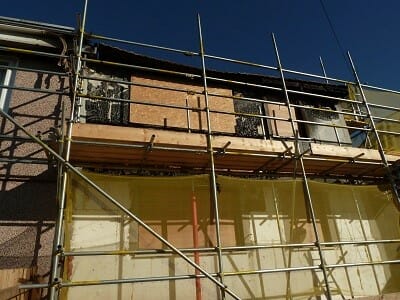
Fermacell boards were the only element of an EWI project left standing after a house fire.
Gypsum fibreboard from Fermacell has been commended for helping to prevent the further spread of a house fire.
The semi-detached house was one of 4,000 post-war BISF (British Iron and Steel Federation) properties being refurbished to Decent Homes standards by Plymouth Community Homes housing association in a £168million five-year investment programme.
The fire on a Saturday morning is believed to have been started by a child playing with matches in an upstairs bedroom. All of the family escaped unhurt but the blaze gutted the interior of the steel-framed and steel-clad house and part of the adjoining private property via the roof.
Specialist sub-contractor ECL Contracts had just started to apply render to the EWI which melted in the inferno. The original BISF metal lath also melted and twisted in temperatures believed to have reached 2,000˚C internally.
But the Fermacell panels on the façade of the two-storey house remained unscathed apart from an area around the eaves where the fire brigade had to punch through to gain hose access.
Fermacell’s technical manager Andrew Richardson said: “Feedback from the site was that they were very thankful that the Fermacell was there as it stopped the leapfrogging of the fire to a great extent and thus reduced the risk and potentially saved lives and possible subsequent damage, especially as the fire performance was not the primary reason the board was being used.”
ECL projects manager Steve Morgan said Fermacell had been one of five options as an EWI backer board and had been selected for its Class A2 (half-hour) fire resistance and comparatively light weight.
“The Fermacell panels were fantastic. The whole thing could have been a lot worse,” he said. “This kind of performance gives everyone reassurance in the products we use.”
It is Fermacell’s racking strength as well as its fire resistance which makes it particularly ideal for minimising fire risk during timber-frame builds.
Andrew added: “This event also reinforces the ‘fire protection during construction’ argument that the Structural Timber Association has been pushing.”
